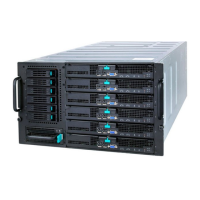Intel
®
Modular Server System Service Guide 69
4 Using the Intel
®
Modular Server Control
User Interface
This section provides an overview of the Intel
®
Modular Server Control for the Intel
®
Modular Server System MFSYS25/MFSYS35. The Intel
®
Modular Server Control User
Interface (UI) provides complete system hardware management by enabling users to
securely configure and monitor the system. The system is intended to be managed over a
secure, private management network. It is recommended that the Intel
®
Management
Module not be connected to a publicly accessible network.
Full system management is only supported via the Intel
®
Modular Server Control. In
addition to the Intel
®
Modular Server Control UI, administrators can access system-level
information remotely via SNMP. For information regarding SNMP v2 and v3 support,
refer to the installed Unified Firmware Update (UFU) Release Notes.
This section covers the Intel
®
Modular Server Control UI features and provides detailed
instructions for configuring the modular server system.
Introduction
The Intel
®
Management Module provides a simple and intuitive browser-based graphical
user interface that IT administrators can use to monitor and configure the Intel
®
Modular
Server System MFSYS25/MFSYS35. This GUI is referred to as the Intel
®
Modular
Server Control UI. No CDs or additional installation steps are required to use the UI. To
initially launch the UI and configure the system hardware, a default static IP address and
user account are provided. After logging into the UI, IT administrators can:
• Quickly access system and component information.
• Configure and manage storage subsystems, including but not limited to:
— Create, delete and/or rename a storage pool
— Create, delete, rename and/or reassign a virtual drive to a compute module
— Create or delete hot spares
• Configure and manage switch modules, including but not limited to:
— Assign internal and external ports to a virtual LAN (VLAN)
— Configure external port settings
— Launch an Advanced Configuration for additional switch configuration features
• Quickly view hardware inventory, system event logs, storage allocation and system
configuration reports.
• Easily view current status for all hardware components (servers, hard drives, switch
modules, storage control modules, management module, cooling modules, and power
modules).

